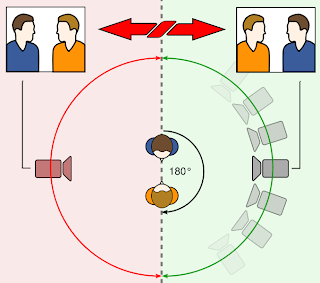 When filming, the cameras should not cross over the 'line of vision' because it makes it easier for the viewer to understand the story without the complication of moving the cameras around trying to avoid set etc. From this 180 degree line the cameras can hit angle angle of the scene, and the story is able to flow without cutting because of accessibility to cameras. This rule are mainly used with soap operas but they are always used in interviews. The diagram shows this. A good example of this would be the Beyonce Knowles video.
When filming, the cameras should not cross over the 'line of vision' because it makes it easier for the viewer to understand the story without the complication of moving the cameras around trying to avoid set etc. From this 180 degree line the cameras can hit angle angle of the scene, and the story is able to flow without cutting because of accessibility to cameras. This rule are mainly used with soap operas but they are always used in interviews. The diagram shows this. A good example of this would be the Beyonce Knowles video.(video is on my other post)
Storytelling is used quite a lot in today's music videos. They add a narrative to their video to add the experience and draw the audience in. The majority of music videos that have a narrative use cutaways to include them so they cut back from the artist or band in a studio to the flowing narrative. http://www.youtube.com/watch?v=AZpA8lErxTo. This video Leona Lewis - a moment like this has a narrative of her journey throughout the series of the x factor. It cuts from her singing in a studio or a location to her taking a journey. What it does is it has the cutaways in black and white to give the effect of it being different to her in the studio and also to act like its the past. This could emphasise the past being the past and there's going to be colour for her future.
Music videos use combinations of shots. When there is a band that have 4 members, with them all playing an instrument you have to get a variety of shots, for example, closeup on all faces, wide shot of the whole band, and closeups of all instruments being played.
http://www.youtube.com/watch?v=aCyGvGEtOwc This video give examples of these shots. These shots are very abstract and quick. They used cross cutting in most shots without any fades to go with the beat. Many shots are high angle or low angle to stick to the mad style. I noticed as well the shots are very short and sharp. they was a lot of creating pace in this video by having these quick shots.
History of editing
It started off in 1920, where the first music video was created by Bessie Smith. It was called St Louis blues. It took one take filmed in black and white and the majority of the editing was done instantly. This is called in-camera editing. So having to film in order the way it was written in the story board. Moving onto the 1940s, Disney became very popular and draw the children's attention to the classical music by having an animated film to watch whilst the music is playing. In 1964, they established cutting. This is cutting the film and gluing back together so it will flow. This shows the progression of editing. The editing throughout became more complex ed and more effective. They began to reverse the shot, include lighting, and having a more variety of shots such as high angle and low angle shots. Today's editing is extremely in detail such as having software such as final cut pro where you can add colour effect, fades, dissolves which can add effect to transitions and cuts.